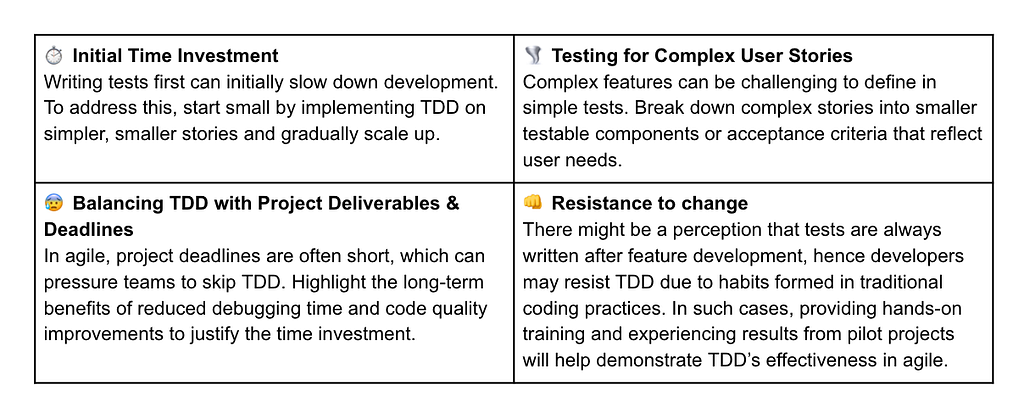
A practical approach to TDD in Agile
👋🏼 Hello everyone! In this article, we’re looking into Test-Driven Development (TDD) — one of the shift-left testing models in Agile. We’ll explain what TDD is, its benefits and challenges, and provide a practical approach to adopting TDD in agile projects.
TDD is a software development process that emphasises on writing tests before coding, ensuring every piece of functionality is thoroughly tested. In Agile projects where rapid iterations and flexibility are the keys, TDD offers the advantage of building quality into the development cycle.
In large organisations, technical debt and code refactoring often become negotiable parts of agile sprints. TDD in agile projects promotes code reliability, streamlines debugging, and enables team collaboration, all of which help to produce robust software faster.

Understanding TDD and its benefits
At its core, TDD is a 3-steps cyclic “Red-Green-Refactor” process:

In Agile projects, TDD aligns seamlessly with short, iterative sprints and focuses on quality and quick delivery. Some of the key benefits TDD in Agile are:

Generic TDD Workflow in Agile projects
Here’s how the TDD workflow typically looks in an agile project:
1. Sprint Planning
In sprint planning, user stories are broken down and acceptance criteria are established. This provides a clear basis and documentation for writing tests.
2. Writing the test (Red)
For each user story, the engineer plans the different coding tasks either as sub-task(s), or as a simple checklist. For each task item, identify all possible test cases that verifies the desired behaviour. Tests can be written in the unit, integration or UI level, wherever applicable.
3. Passing the test (Green)
With the failing test case as a guide, the developer writes the minimum amount of code necessary to make the test pass.
4. Refactoring (Refactor)
The code is then refactored to improve quality, structure, and maintainability while ensuring the test still passes.
5. Test Execution & CI/CD
Automated tests are run within a Continuous Integration/Continuous Deployment (CI/CD) pipeline, providing immediate feedback on code changes.
Integrating TDD into the agile sprint cycle in this way ensures that testing is not an after-thought, but an integral part of development. This workflow allows agile teams to address quality and functionality incrementally, aligning TDD’s incremental testing approach with Agile’s iterative nature.
Common challenges & how to overcome them
While TDD offers substantial testing benefits, project teams may encounter challenges when implementing it. Here are some common challenges and strategies to address them:

Practical Approach to adopting TDD in Agile projects
To adopt TDD in an agile project, start with a structured, phased approach that gradually introduces TDD principles into the team’s workflow. Here’s a practical 7-steps guide for getting started:
1. Pilot with simple user stories
Begin with simple, small-scale user stories to give the team hands-on experience with TDD. Aim to cover basic functionality first before tackling complex cases.
2. Set up a test framework
Select a test framework compatible with your language and development environment, such as Mocha or Vitest for Javascript. Ensure it integrates with your CI/CD pipeline for seamless testing.
3. Write tests with user stories in mind
Align tests closely with the user stories and acceptance criteria in Agile. For instance, if a story involves a login function, the initial test should check for successful login conditions i.e. happy paths.
4. Practice Red-Green-Refactor
Stick to the Red-Green-Refactor cycle strictly. Write a failing test, write only enough code to pass the test, and refactor for quality. This discipline ensures the code meets requirements without over-engineering.
5. Integrate TD into CI/CD pipeline
Set up automated testing in your CI/CD pipeline to validate changes continually. Automated tests provide fast feedback, helping to identify issues early and ensure quality in every sprint.
6. Encourage team collaboration
Hold workshops or pair-programming sessions to get the team comfortable with TDD. In Agile, where teamwork is emphasised, TDD should be a shared responsibility, allowing testers and developers to work closely together on test cases.
7. Review & Retrospective
At the end of each sprint, review the effectiveness of TDD practices. Gather feedback on what worked well and what can be improved, using retrospectives to refine the TDD process for future sprints.
By following these steps, agile teams can gradually incorporate TDD into their workflow, starting small and scaling up as the team becomes more comfortable with the process.
Best practices for sustaining TDD in Agile
Sustaining TDD in Agile requires ongoing commitment and adherence to best practices that ensure its effectiveness:
- Keep tests small and focused:
Each test should verify one specific behaviour. Besides, small tests are easier to debug and maintain, ensuring that each failure points to a distinct issue. - Automate regression tests:
Incorporate TDD tests as part of your regression test suite; this allows the tests to continuously validate the application and catch issues early. - Refactor relentlessly:
Refactoring should be done continuously, not only after the code passes the tests. Regular refactoring keeps the code clean, organised and adaptable to new changes. - Write readable tests:
Test code should be readable and clear like production code; all team members should understand the test cases, making collaboration and maintenance easier. - Involve the Quality Engineers (QEs) early:
Engage QEs from the beginning to review and suggest improvements to test cases. QEs can also help understand traceability of tests to requirement (user stories), and ensure sufficient test coverage.
By following these best practices, Agile teams can keep TDD processes efficient and effective, maintaining code quality and maximising the benefits TDD offers in agile environments!
Implementing TDD in agile projects fosters an environment where quality is central to the development process, enabling teams to produce more reliable, maintainable code. Adopting TDD may seem challenging initially, especially in fast-paced agile projects. However, with consistent application, the benefits of TDD - reduced bugs, improved code quality, and better alignment with user stories - become apparent, reinforcing its value.
Agile teams that embrace TDD can expect to deliver higher-quality software that meets user needs while streamlining the development process for more efficient and enjoyable sprints.
If you have questions or more tips to share with us, do make use of the comments section below. See you again soon!
🧙🏼♀ Team Merlin 💛
Application security is not any individual’s problem but a shared responsibility.
A practical approach to TDD in Agile was originally published in Government Digital Products, Singapore on Medium, where people are continuing the conversation by highlighting and responding to this story.
